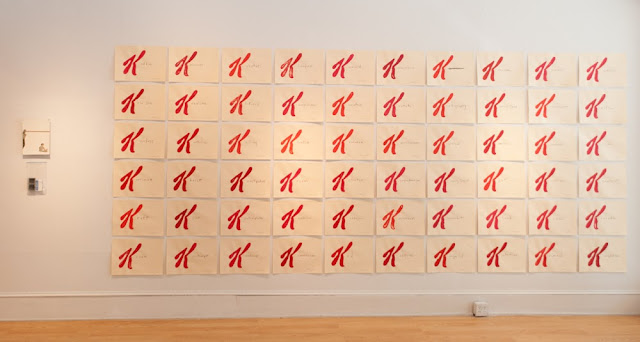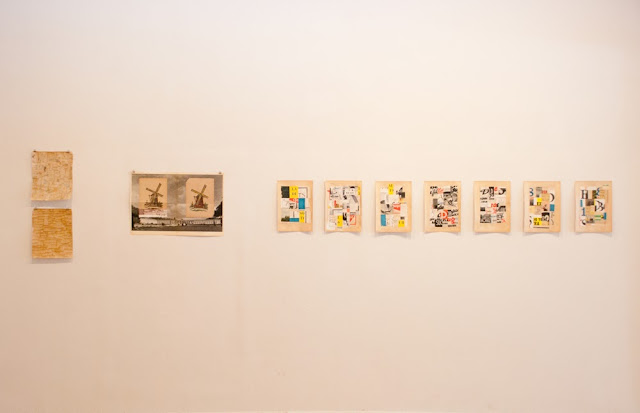By Patti Verbanas
Matthew Rose’s “Confessions, Obsessions and Indiscretions” May 9 -June 14, 2009 at SOMA Gallery, Cape May, New Jersey.
Matthew Rose, an American artist living in Paris, has been “spelling with scissors” for more than 25 years. Trained in semiotics and linguistics, Rose creates works — often exhibited in a wall-to-wall and floor-to-ceiling display — that challenge viewers’ perception of the interrelationships between seemingly disparate objects and words.
I spoke with Matthew Rose on the eve of his opening to discuss the inspiration behind the works presented in “Confessions, Obsessions, and Indiscretions” — a range of pieces including surrealist prints, drawings on paper, text works, paintings, large collage works on canvas, and, as Rose describes them, “terribly unusual objects.” “I wouldn’t say they are naughty, but they are certainly provocative,” he notes.
What is the theme of “Confessions, Obsessions & Indiscretions?”
MR: The work concerns multiple — actually thousands — of secret messages about myself and, by extension, the world we all inhabit. They are not therapeutic works. They are about everyday life when it’s mashed up, which is perhaps its natural, somewhat entropic, state. The exhibition is also an invitation to others to not only participate in my chaotic theory of everything, but to participate by extension in theirs — no matter how strange.
What are your obsessions and do you have any confessions that you divulge in this show?
MR: My confessions? I fear the real meaning in all this work is my death — even the sexy pieces, the funny pieces — and the absurdity of sex and love. How terrifying it all is. But I try to make myself laugh and see what my mind sees.
Where you do derive inspiration for your subjects?
MR: I just walked down the street to a cafe in my neighborhood in Paris and noticed how the sidewalk, once marked up with bright white arrows telling dog owners to move their pups to the curb for their pooping, is now a bit of chop suey, with only bits of the arrows remaining after some hole was dug or some pipe laid into the street and asphalt relaid. It’s quite beautiful, time working its collage magic on the world. I try to do that, but of course, toss in all my personal nonsense. So I’ll start with some element of an advertisement, a logo, picture of a bottle or can, or a discolored piece of paper and connect, distort, and build them out and up, until the work sings, and says, “I’m finished.” Perhaps months later I go back to it and see that I’ve tricked myself and hit it with steel wool or shower hose and see what happens. You have to murder your work from time to time to see what’s really there.
Tell us about how you “spell with scissors.”
MR: I cut out meaning and color (a pair of blue eyes from some Weimar general, some girl’s red hair from 1930s America, a bone in a jar of water) and make essays and novels out of them. Then I toss up the “phrases” and let them fall. They begin to behave like nouns and verbs and objects.
What does the medium of collage allow you to do that other art forms do not?
MR: Collage allows me to say things rapidly and see the world how it really could be (or is). It’s like speaking and reflects my consciousness in a way that other mediums do not. I use paint, pencil, paper, and canvas all the time, and will forego collage if there is some place I need to get to.
I do all these things to see what they look like, and oftentimes they are truly curious. In “Immaculate Perception” I cut out the head of a little girl from a French knitting magazine from the 1930s. I loved it; she looked down and away and had a lovely bobby haircut. I walked around in my studio with this little head for a while until I remembered an illustration of a lemon tree I’d cut out of another French book on fruit plants. I put them together, and it was very satisfying. I could never have connected them by paint. I needed the physical objects, the color before my eyes, the ideas they each presented for me to marry them. It’s quite simple, and for me a lemon and a little girl will never be the same. It’s a bit different with another collage I made, “LeMon,” which steals a fashion photo of a woman, a slice-and-dice of the logo of the French newspaper Le Monde, a blue ZERO, and some yellow paint. It’s “LeMon,” now and the woman has “blue lips” (from the lemon). It’s sexy and very strange. Collage is the world colliding with you.
What can you tell us about your novel, Plan B, which you will read from at the gallery on opening night?

MR: Plan B is a novel about my confessional, obsessional, and extremely indiscrete anti-hero, Von Spatzl. He is Dada incarnate. I wrote it over the course of two years, creating a parallel book in images — in fact, Von Spatzl’s collages and drawings. Von Spatzl is a lost and suicidal fantasist, who after failing repeatedly to kill himself goes off to play chess, writes novels and, in his search for quality discovers the Austrian Girl, an ex-call girl who plays Omm Pah Pah music on her accordion. The adventures continue in a cut-and-paste fashion, with Von Spatzl trading stocks in the late 20th century and making a fortune in his tiny, dusty house in Flushtown, America. His accomplishment is to send piles of cash to his mother in Florida, lose contact with the world, and disappear into the fog after he has buried his night and day journals in his back yard. It is a black novel that borrows from William Burroughs’ cut-up books and my own collage methods. It’s dark, but funny. Whenever I read it to people they laugh nervously — but they do laugh. I offered it as a free download on my website: http://matthewrosestudio.net/
When did you know you wanted to be an artist?
MR: It’s not as if I wanted to be an artist, but simply something I’ve always done — made things with my hands for my eyes to see and my brain to consider. Maybe I didn’t have a choice, but as soon as I could see (and remember) I found myself fascinated with color, texture, lines and objects, and quantities of objects and how they all seemed to shift around to draw out different meanings. Looking/reading is my favorite thing to do, so I suppose I’m an aesthetic by nature. As a child I liked how a slice of hard, acid orange-colored cheddar cheese sat on an innocent slice of white bread. I would write letters to people and saw my words as visual units. They spoke to me these combinations, connections. And when my wonderful Aunt Selma took me to see van Gogh’s exhibition in Brooklyn when I was 7 years old, I was hooked by his blue skies and pink almond tree blossoms. Strange beauty. I began to see in a new way and make my own skies and almond trees, albeit ones quite different than van Gogh’s. I lived this way as a kid, and still do — super-conscious, and exhausted by it all.
What artists have influenced your work? What keeps you from being derivative?
MR: There are many artists in my life, but the world and the street is my greatest teacher. The stuff that washes up on my doorstep, the accidents, the events that happen in a blink. Like today, I saw a woman get hit by a car. But she claimed she wasn’t hit. I saw her flip in the air. After I helped her up from the street, I listened to her, the driver, and the other witnesses discuss the event. She seemed all right, and after 10 minutes she got on a bus and disappeared back into the world. Like a letter mailed to no one. On the street were the scuff marks of her boots. Traffic returned to normal.
My late friend Ray Johnson, himself a great collage artist, gave me a way of looking and reading that has stayed with me ever since: Synchronicity. (Synchronicity is the experience of two or more events, which are casually unrelated occurring together in a supposedly meaningful manner.) I see artists from all of history talking to me in this way — from the cave scribblers in Lascaux to Michelangeolo, Hogarth, and Manet. There’s the odd realism of Schwitters and odd optics and games of Duchamp. The energetic acrobatics of Rauschenberg and the cool detachment of Jasper Johns. The shamanistic conundrums of Yves Klein and Pierro Manzoni, and the Fluxus group. I suppose the poetic discourses of Cornell and Ray Johnson have had the strongest effects on me — the way they matched disparate pieces of the world together to create something completely new speaks about the strange combination of banality and magic. Birds and boxes, found discards in envelopes. In the end, it’s impossible not to be derivative — art is of this world, there are scuff marks everywhere.
New Jersey Life Lifestyle Editor Patti Verbanas is the former Executive Editor of Art & Antiques magazine. Matthew Rose's current exhibition, The Letters, is on view from 5 July - 31 August 2013 at Converge Gallery, Williamsport, PA.






















